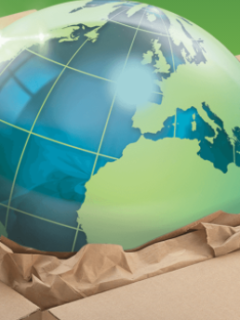Choosing the right type of packaging is a strategic factor for any business. It not only protects the products and optimises storage costs, but also provides an important opportunity to convey the brand’s image. However, not all packaging is equal: There is primary packaging, secondary packaging and tertiary packaging, each with its specific functions.
How is packaging classified?
Packaging is classified into three main categories, defined by EU Directive 94/62 CE from 1994, which aims to reduce the environmental impact of packaging:
- Primary packaging: This is the packaging that comes into direct contact with the product. It protects and preserves the product, and also ensures compliance with labelling regulations. Common examples include bottles, jars, blister packs and food wrappers.
- Secondary packaging: This is designed to hold multiple sales units or multiple primary packages, simplifying handling and transport, and also acting as a branding tool. Cardboard boxes, bags, sacks, multi-packs and shelf displays belong to this category.
- Tertiary packaging: Used to group and consolidate secondary packaging for transport and storage. Examples include pallets, stretch film and strapping for securing loads.
This classification not only facilitates the handling of materials in the production and logistics chain, but also supports the correct sorting and recycling of materials.
What is primary packaging?
Primary packaging is the first level of protection for the product, the one that comes into direct contact with it and ensures its integrity. The choice of material is very important for food, pharmaceutical or cosmetics packaging, as it needs to provide a barrier against dust, moisture, bacteria and other external factors.
What are the functions of primary packaging?
- Product safety: Protects against impact, contamination and changes caused by light, air or extreme temperatures.
- Identification and information: Must contain essential information such as product name, ingredients, expiry date, batch number and instructions for use, and ensure compliance with labelling regulations.
- Attractiveness: In a retail context, primary packaging must also grab the customer’s attention, often by integrating branding elements such as logos and appealing graphics.
Preferred materials:
Primary packaging includes materials such as food-grade plastic, glass, aluminium and cardboard, chosen based on the nature of the product and its preservation needs.
What is secondary packaging?
Secondary packaging is designed to contain multiple units of sale or primary packaging. This type of packaging optimises logistics handling, facilitates transport and provides an additional surface that is ideal for communicating the brand.
The main functions of secondary packaging:
- Space optimisation: Thanks to stackable and palletisable designs, secondary packaging reduces storage and transport costs.
- Branding: Often decorated with logos or graphic elements, the packaging enhances the customer experience and strengthens the company’s visual identity.
- Extra protection: Ensures products reach the customer in perfect condition and reduces the risk of damage during handling.
Preferred materials:
Secondary packaging can be made from corrugated cardboard, recycled plastic or environmentally friendly packaging, such as compostable materials, which are increasingly in demand by consumers concerned about sustainability.
What is tertiary packaging?
Tertiary packaging is the third level of protection and is used to group secondary packaging, making transport and storage more efficient. It is essential for moving large quantities of goods in a safe and stable way.
What are the main functions of tertiary packaging?
– Consolidation of cargo: Tools such as pallets and straps ensure that secondary packaging is well positioned, preventing movement during transport.
– Efficient logistics: Thanks to solutions such as stretch film or strapping, tertiary packaging facilitates handling and minimises damage from shock or vibration.
– Sustainability: Recyclable materials, such as compostable film or PP tapes, can reduce environmental impact and support corporate sustainability strategies.
Common examples of tertiary packaging:
- Pallets: Essential for stabilising and transporting large quantities of products.
- Stretch film: Encloses loads to protect them and keep them stable.
- Strapping: Ensures that the boxes on the pallets remain compact and secure during transport.
The new European packaging rules (2024):
In 2024, the European Parliament adopted new rules to make packaging more sustainable, promote a circular economy and reduce waste across the EU/EEA. These rules set progressive targets to reduce packaging waste, aiming for a 5% reduction by 2030, 10% by 2035 and 15% by 2040. The new provisions also aim to promote reuse, introduce specific obligations for certain industries, and improve recycling by setting criteria for the use of recyclable materials. For example, single-use plastic products and packaging made from materials that are difficult to separate will be subject to tighter restrictions.
These changes represent an important step towards sustainability, aligning the industry with the EU’s climate goals.
Why is it important to choose the right type of packaging?
Each type of packaging has a specific role in the protection, handling and marketing of products. Understanding the types of packaging and choosing the most appropriate materials and solutions for your needs can make a difference in terms of cost, efficiency and sustainability.
If you’re looking for packaging selection support or personalised advice, RAJA is your ideal partner. Discover our solutions for secondary and tertiary packaging, designed to meet all needs, from e-commerce to industry. You’ll find our full product range in our online store.
Choosing the right type of packaging is a strategic factor in protecting your products, optimising logistics processes and enhancing your brand. With the introduction of new European regulations, choosing sustainable solutions to reduce waste, promote reuse and improve recycling is becoming increasingly important. Adopting effective and innovative packaging is not only a response to legal requirements, but also an opportunity to strengthen relationships with consumers who are increasingly concerned about the environment. With RAJA, you can rely on customised solutions, designed to ensure efficiency, safety and sustainability, regardless of your type of business.
Investing in well-thought-out packaging isn’t just a detail: it’s a step forward in improving your processes and your environmental impact, turning it into a true competitive advantage.
Feel free to contact our customer centre on 22 51 40 00 or post@rajapack.no for advice on which packaging is best for your business!














